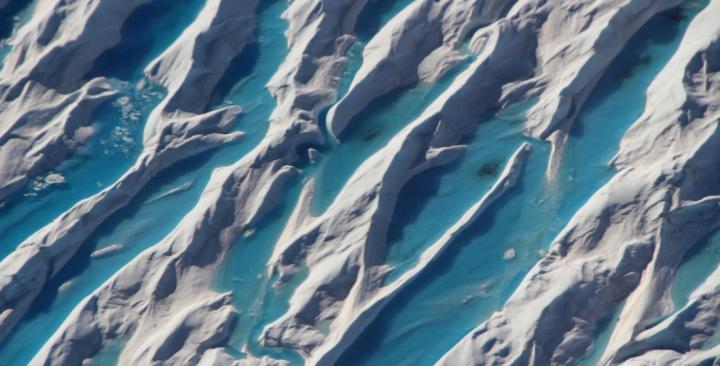Greenland's southwest ice sheet particularly sensitive to warming

Melt ponds on the Greenland Ice Sheet. Credit: NASA / OIB / John Sonntag
The ice fields of southwest Greenland are becoming particularly sensitive to a climate cycle called the North Atlantic Oscillation as global warming proceeds, reports an international team that includes a University of Arizona geoscientist.
The largest sustained ice loss in Greenland from early 2003 to mid-2013 came from summertime melting of the ice fields in southwest Greenland, the researchers found. Their study is published this week in the Proceedings of the National Academy of Sciences.
“When we see really big changes in southwest Greenland, we can be sure it's atmosphere-related, because it's an increase in surface melt,” said co-author Christopher Harig, a UA assistant professor of geosciences.
Unlike other parts of Greenland, the southwest region has few glaciers. It loses ice when warmer temperatures melt its ice sheets, generating a network of rivers that flow above and below the ice into the ocean.
As global warming progresses, southwest Greenland will become a major contributor to sea level rise, the researchers write.
“In the next 50 years, we're expecting a lot of atmospheric warming,” Harig said. “If Greenland is sensitive to the warming, we're going to see a lot of ice loss and therefore we're going to see a lot of sea level rise.”
The study's title and a list of co-authors is at the bottom of this news release. The National Science Foundation funded the research.
Figuring out the connection between warming in southwest Greenland and the North Atlantic Oscillation, or NAO, climate cycle began when Harig noticed that in 2013 and 2014, the amount of ice being lost from Greenland changed.
Harig and co-author Frederik Simons of Princeton University were measuring the loss of snow and ice covering Greenland by using monthly satellite data from the Gravity Recovery and Climate Experiment, or GRACE.
As Greenland's ice melts, it changes the Earth's gravitational field slightly, which can be detected by GRACE.
“We found a year that was really different from the past 10 years,” Harig said. “The melting was getting worse every year–and then took a break from getting worse.”
He and his colleagues were puzzled about the slowdown, so they contacted Michael Bevis of The Ohio State University in Columbus to see whether the network of GPS receivers along the coast of Greenland showed the same phenomenon.
The GPS receivers are attached to bedrock. When large amounts of ice melt, the surface rebounds because it is no longer weighed down by that mass of ice. The network allows scientists to detect that rebound and calculate how much ice was lost.
The Greenland GPS network had recorded the same slowing of ice loss during the same time period.
The slowdown in melting lasted from about 12 to 18 months. The researchers found the slowdown coincided with the NAO swinging from its negative phase to its positive phase.
During the negative phase, Greenland has less snowfall and more sun, and melting increases. In contrast, during the positive phase, Greenland is colder and cloudier, so the ice melts less.
When the NAO flipped back to its negative phase in 2015, the rate of melting starting climbing again.
“We make a compelling case that the North Atlantic Oscillation is really driving this inter-annual variation in ice loss,” Harig said.
“I continue to be interested in understanding the causes of ice loss in Greenland,” he said. “This next decade is really about getting a lot more specific about what's causing ice loss here rather than over there.”
Harig, Simons and Bevis's co-authors on the paper “Accelerating changes in ice mass within Greenland, and the ice sheet's sensitivity to atmospheric forcing” are Shfaqat Khan and Per Knudsen of the Technical University of Denmark in Copenhagen; Abel Brown, Eric Kendrick and Dana Caccamise of The Ohio State University; Michael Willis of the University of Colorado in Boulder; Xavier Fettweis of the University of Liege in Belgium; Michiel van den Broeke of Utrecht University in the Netherlands; Finn Madsen of the Danish Technical University in Copenhagen; Tonie van Dam of the University of Luxembourg; and Thomas Nylen of UNAVCO Inc. in Boulder, Colorado.
###
Chris Harig
520-621-2070
charig@email.arizona.edu
Media contact:
Mari N. Jensen
520-626-9635
mnjensen@email.arizona.edu
Media Contact
More Information:
http://dx.doi.org/10.1073/pnas.1806562116All latest news from the category: Earth Sciences
Earth Sciences (also referred to as Geosciences), which deals with basic issues surrounding our planet, plays a vital role in the area of energy and raw materials supply.
Earth Sciences comprises subjects such as geology, geography, geological informatics, paleontology, mineralogy, petrography, crystallography, geophysics, geodesy, glaciology, cartography, photogrammetry, meteorology and seismology, early-warning systems, earthquake research and polar research.
Newest articles

First-of-its-kind study uses remote sensing to monitor plastic debris in rivers and lakes
Remote sensing creates a cost-effective solution to monitoring plastic pollution. A first-of-its-kind study from researchers at the University of Minnesota Twin Cities shows how remote sensing can help monitor and…

Laser-based artificial neuron mimics nerve cell functions at lightning speed
With a processing speed a billion times faster than nature, chip-based laser neuron could help advance AI tasks such as pattern recognition and sequence prediction. Researchers have developed a laser-based…

Optimising the processing of plastic waste
Just one look in the yellow bin reveals a colourful jumble of different types of plastic. However, the purer and more uniform plastic waste is, the easier it is to…



